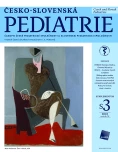Multiple endocrine neoplasia in childhood
Authors:
Pomahačová Renata; Paterová Petra; Nykodýmová Eva; Polák Petr; Sýkora Josef
Authors‘ workplace:
Dětská klinika, Lékařská fakulta a Fakultní nemocnice v Plzni, Univerzita Karlova v Praze
Published in:
Čes-slov Pediat 2023; 78 (S3): 17-21.
Category:
Comprehensive Report
doi:
https://doi.org/10.55095/CSPediatrie2023/057
Overview
Multiple endocrine neoplasia syndromes (MEN syndromes) are rare autosomal dominantly inherited diseases with the occurence of tumors of two or more endocrine glands, with possible manifestation in early childhood. A late diagnosis of MEN syndrome can be fatal for an individual. Early identification of at-risk individuals is therefore crucial for the prevention and treatment of potentially life-threatening endocrine and non-endocrine neoplasias. MEN 2B syndrome has the most serious prognosis due to highly aggressive medullary thyroid carcinoma with early postnatal development and a high prevalence of de novo mutations. Knowledge of the non-endocrine features of this syndrome may lead to early diagnosis before the development of advanced malignant disease. We describe the latest knowledge about MEN syndromes with a focus on clinical symptoms, genetic background, genotype-phenotype correlation in MEN 2 syndromes, American Thyroid Association guidelines for screening of tumors and their treatment in children.
Keywords:
multiple endocrine neoplasia, medullary thyroid carcinoma, primary hyperparathyroidism, insulinoma, gastrinoma, nonendocrine features of MEN 2B
Sources
1. Jacob M, Rowland D, Lekarev O, et al. Multiple endocrine neoplasia in childhood: an update on diagnosis, screening, management and treatment. Endocrines 2022; 3(1): 76–91.
2. Wells SA, Asa SL, Dralle H, et al. Revised American Thyroid Association guidelines for the management of medullary thyroid carcinoma. Thyroid 2015; 25(6): 567–610.
3. Brauckhoff M, Machens A, Hess S, et al. Premonitory symptoms preceding metastatic medullary thyroid cancer in MEN 2B: an exploratory analysis. Surgery 2008; 144: 1044–50.
4. Castinetti F, Moley J, Mulligan L, et al. A comprehensive review on MEN2B. Endocr Relat Cancer 2018; 25: T29–39.
5. Redlich A, Lessel L, Petrou A, et al. Multiple endocrine neoplasia type 2B: Frequency of physical stigmata-Results of the GPOH-MET registry. Pediatr Blood Cancer 2020; 67: e28056.
6. Cohen MS, Phay JE, Albinson C, et al. Gastrointestinal manifestations of multiple endocrine neoplasia type 2. Ann Surg 2002; 235(5): 648–
654.
7. Pomahacova R, Paterova P, Nykodymova E, et al. Cystic ovarian teratoma as a novel tumor and growth hormone deficiency as a new condition presenting in multiple endocrine neoplasia type 2B: Case reports and review of the literature. Biomed Pap Med Fac Univ Palacky Olomouc Czech Repub 2022; 166(1): 105–111.
8. Castinetti F, Waguespack SG, Machens A, et al. Natural history, treatment, and long-term follow up of patients with multiple endocrine neoplasia type 2B: an international, multicentre, retrospective study. Lancet Diabetes Endocrinol 2019; 7(3): 213–220.
Labels
Neonatology Paediatrics General practitioner for children and adolescentsArticle was published in
Czech-Slovak Pediatrics

2023 Issue S3
Most read in this issue
- Anorexia nervosa from an endocrinologist's point of view
- Multiple endocrine neoplasia in childhood
- Current view on the diagnostics of growth hormone deficiency in childhood and adolescence
- Pubertal growth in children born small for gestational age (SGA) with persistent short stature (SGA-SS). Growth hormone treatment outcomes from data of the Czech countywide REPAR database
